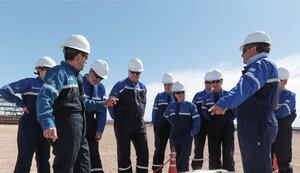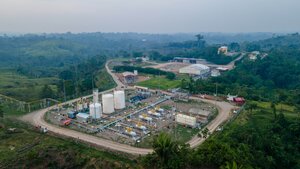The Energy Report: Chad, is there a major investment theme that you expect to dominate 2014?
Chad Ellison: From our perspective covering the Canadian exploration and production (E&P) sector, the dominant theme is going to be the weakening Canadian dollar and its relation to higher realized commodity prices. We've recently been seeing strength in both natural gas and oil. Western Texas Intermediate (WTI) has increased and Canadian differentials have come down.
TER: What's your 2014 price deck for WTI and Brent, especially in light of stronger economic data from China?
CE: We currently forecast $92.25/barrel ($92.25/bbl) for WTI and $105/bbl for Brent.
TER: Last year, the price differential between AECO Hub and NYMEX natural gas futures proved to be a significant investment theme. Should investors expect that differential to be a major investment theme again this year?
CE: I don't believe it'll have the same impact this year. Last year, the AECO blowout was caused by a change in the toll structure on the Canadian natural gas Mainline and gas volumes from Alberta essentially being displaced by cheap Marcellus gas. TransCanada Corporation (TRP:TSX) increased its interruptible service tolls, which caused shippers to fill up storage in Alberta rather than pay the fees to ship down the Mainline. However, we saw an increase in parties signing up for long-term service over the winter, which has worked to reduce the interruptible tolls to a more normalized level. While we may see some potential for volatility in the summer, we shouldn't expect anything as dramatic as last year.
TER: The cold winter has left gas inventories low. How long do you think it will take to replace those inventories?
CE: It's tough to say. U.S. natural gas has already returned to previous production levels after the freeze-offs from the cold weather. That said, full replacement of those depleted inventories will be dependent upon weather and demand. If it's not abnormally hot, inventories will be back in the mid-range by the time injection season is done in November. But if gas prices do persist higher, we could see a lot of gas-to-coal switching, as that looks pretty favorable at this time.
TER: Do you expect the Henry Hub price to drop even more dramatically than it has over the last few days once the Western winter and the polar vortex ends?
CE: Yes, that's a possibility. The forward strip still shows a decline in spring and a return to the $4 level in summer, but natural gas storage will be below 1 trillion cubic feet (1Tcf) for the first time since 2003. That's a lot of gas that has to be replaced.
It will depend on the weather. If the recent cold winter is followed by a hotter-than-normal summer, we can expect to see increased power demand, which will slow the rate of injection and could cause high natural gas prices to persist.
TER: The Henry Hub price of roughly $6/million British thermal units ($6/MMBtu) is about 50% higher than it was a year ago. Are we going to return to those former prices or is it going to be somewhere in the middle?
CE: It will be somewhere in the middle—we're forecasting an average of $4.15/MMBtu for 2014. The storage indications mean that prices will be in the $4 range, but I can't see them going down significantly until a lot of that natural gas in storage is replaced.
TER: How are the companies in your coverage universe gaining greater exposure to higher natural gas and crude prices? Are you seeing increased price hedging as commodity prices rise?
CE: A large portion of the companies in our coverage universe are fairly well hedged already. When the gas price started to turn, companies locked in a lot of their volumes. As you look out on the forward strip for natural gas, the price does decline pretty dramatically in the spring. Although we've seen high prompt-month gas prices, it hasn't allowed companies to lock in that level for the full year.
TER: Despite higher crude prices, majors like Exxon Mobil Corp. (XOM:NYSE) and Chevron Corp. (CVX:NYSE) are seeing their margins shrink due to higher costs. Does that underperformance allow companies in your coverage universe to find more time in the spotlight, or is there cost creep and trimmed margins in your space, too?
"The dominant theme in the Canadian E&P sector is going to be the weakening Canadian dollar and its relation to higher realized commodity prices."
CE: Most of the companies in our coverage universe are smaller junior and intermediate companies. These companies have smaller programs that allow them to be more nimble in deploying capital. We haven't seen any significant cost increases, and several of our companies have even reported successful cost reductions. However, if strong commodity prices continue, I expect we will see increased capital budgets on the other side of spring break-up, which could put some upward pressure on service costs later in the year.
TER: When picking companies, do you look for those with an ideal mix of oil and gas?
CE: At the moment, I prefer 60% oil-weighted names. Until this past winter, I would have said the oilier, the better—a lot of the 90%+ oil-weighted companies have traded at significant premiums. But we are now seeing a lot of demand for gas exposure, and companies that are a blend of oil and gas are benefiting on both sides. However, in the medium term, we're still far more constructive on oil than we are on gas.
TER: The Canadian dollar has fallen dramatically over the last six months. How is the situation affecting the Canadian juniors you evaluate?
CE: Companies are essentially paid in U.S. dollars, but their costs remain in Canadian dollars, so the current environment has shaped up to be a big win for Canadian producers. We've also seen oil price differentials narrow since Q4/13. As a result, we're expecting the majority of our coverage universe to post strong cash flow in Q1/14.
TER: Some of the companies that you cover were having trouble raising cash. However, Tamarack Valley Energy Ltd. (TVE:TSX.V) recently raised $60.2 million ($60.2M) in an equity offering. Is capital more readily available now than it was last year?
CE: Yes, some capital returned to the space in Q4/13, with a host of companies raising money for acquisitions, acceleration and debt reduction. Overall market sentiment seems to have improved, but it's still selective. The favorite names enjoy access to capital while other names trade at a discount valuation, making it difficult to raise money.
TER: Tamarack is your top pick. Why does it merit that status?
CE: First of all, Tamarack has a topnotch management team and has consistently been one of the top operators in the Cardium play. Management remains diligently focused on cost control and has been successful in driving down costs for the company's key plays, which significantly increases the rates of return and economics of those projects.
Second, the company greatly expanded its inventory late last year with a farm-in agreement with a major, which covers more than 110 net sections of Cardium rights and increases its potential Cardium drilling inventory to more than 10 years. Its recent equity raise gave it the ability to accelerate drilling and earn all the lands that it deems prospective as part of the farm-in.
Third, the company still trades at a relative discount to its peers. We forecast it to have top growth rates of 30%/share next year while maintaining one of the cleanest balance sheets in the space. While other oil-weighted juniors with these properties trade at 6x debt-adjusted cash flow, Tamarack is just more than 4x.
TER: Would you call it a value play?
CE: Absolutely, it's been a value story for a while. Between the farm-in, the equity raise and an acquisition it made last year, Tamarack ranks as one of the best, in my opinion. I think it's only a matter of time until it enjoys that premium valuation, hence our Top Pick recommendation.
TER: Most of your coverage leans toward light oil, but Rock Energy Inc. (RE:TSX) is riding the revived fortunes of heavy oil. Does Rock have any more room left to run?
CE: Rock Energy has had a great run, but it still has further upside potential. The company is yet again trending ahead of its guidance. Current production is estimated to be about 4,500 barrels oil equivalent per day (4.5 Mboe/d). That compares to management's full-year estimate of 4.1 Mboe/d and our forecast of 4.275 Mboe/d.
The company should also be able to take advantage of a pending royalty break at its Mantario oil pool for proceeding with a polymer secondary recovery scheme. Essentially, two-thirds of corporate production is being charged at 25–30% royalty today. That number could drop to 1% in 2015, which could see 2015 cash flow/share come in north of $2 based on our initial estimates.
The company has also been having some strong initial success in delineating its Viking light oil play, which has added some significant inventory. We'll be looking for an update on these items when the company reports its year-end results in late March.
TER: The company is planning to drill 27 wells in 2014.
CE: And that number could grow. The company is ahead of budget on production, and commodity prices are stronger. Management has indicated that it would like to drill one well per section on its Viking acreage to delineate the rest of the land base there, which will go a long way to derisking it and potentially making it a more attractive takeover target.
TER: What rate of success has Rock had with previous drill programs of this scope?
CE: It has been successful in all the wells that it's drilled at the Viking project. Additionally, it has an exploratory program that is looking for other pools similar to its Mantario property, and management is budgeting about a 30% chance of success. The company reported a new pool of discovery in its last operations update for a new Lloydminster pool and we anticipate further details as we hear about its Q1/14 drill program.
TER: Rock has been rumored to be a takeover target for some time. It was rumored when shares were trading below $2, and the price is above $4 today. Who are the potential suitors?
CE: A larger company would be interested given the low-decline nature of Rock Energy’s production. Its first well at Mantario came on at 80 barrels per day (80 bbl/d), and two years later it's still doing 80 bbl/d. It would provide a nice platform of free cash flow that a company could redeploy elsewhere, either to fund drilling or a dividend.
"We are now seeing a lot of demand for gas exposure, and companies that are a blend of oil and gas are benefiting on both sides."
Given its interest in heavy oil, most speculation about a potential acquisition has pointed to Twin Butte Energy (TBE:TSX, Not covered). However, Gear Energy Ltd. (GXE:TSX, Not Covered), which had its initial public offering (IPO) last year, is another candidate. The Viking light oil discovery has opened Rock Energy up to a lot of other potential consolidators, including Whitecap Resources Inc. (WCP:TSX.V), Raging River Exploration Inc. (RRS:TSX.V), and the private company, Teine Energy Ltd. (Not Covered).
TER: Tell us about some other compelling narratives in your coverage universe.
CE: RMP Energy (RMP:TSX) is one of my favorite names right now. The company recently had a milestone catalyst with the successful completion of its pipeline and infrastructure project at Ante Creek on time. To date, it has had tremendous success drilling a Montney oil pool at Ante Creek, which has produced some of the best economics in the basin. Production had been hindered by takeaway capacity, but this was recently remedied with the commissioning of the company's pipeline expansion in March.
We estimate there are more than six wells with capability of 1 Mboe/d each, with another four in various stages of drilling or completion in Q1/14. Compared to prior production levels, which were probably around 7.5–8 Mboe/d, there’s going to be a steep ramp up as this pipeline comes onstream. We believe that its 10 Mboe/d guidance is ultraconservative, and production could be well above 12 Mboe/d in short order.
We recently sat down with management, and I was impressed with its level of preparation to handle the increase in volumes. The company has a dedicated, 24-hour trucking terminal that will be able to take any volumes that won't go down the Pembina mainline.
TER: What sort of cash flow are you estimating?
CE: I'm forecasting production of 11.0 Mboe/d, so I'm ahead of where management is, but ultimately still behind where I think it will end up. That means cash flow/share of $1.31 in 2014, increasing to $1.69 in 2015.
TER: What other companies catch your eye?
CE: Surge Energy Inc. (SGY:TSX) is a dividend-paying company that's pursuing a strategy to moderate the pace of development. It is looking to reduce its decline profile in order to maximize free cash flow to fund a dividend and reduce risk.
Since Paul Colborne took over as Chief Executive Officer and President, he's cleaned up the balance sheet, executed on five oil-weighted transactions and focused on cost reductions that have increased the company's netbacks 32% since Q1/13.
The company is set to grow 3–5%/year (by management's estimates and our forecast) and offers an attractive 9.4% yield. It is paying debt down to provide greater returns and is cheap compared to some of its peers.
TER: Tell us about the company's recent exploration success.
CE: Surge's Valhalla Doig wells were some of the best producers in the basin last year. The company managed to extend its Valhalla play further north, which in turn expanded its inventory. The company is only planning on drilling three to four wells per year in the play, but with initial production capabilities of more than 600 bbl/d, it makes it pretty easy to replace declining production.
TER: And finally?
CE: Finally, Cardinal Energy Ltd. (CJ:TSX) is another dividend-paying company. The company just had its IPO in December and is led by the former Midway Energy Ltd. management team. Cardinal was designed to be the ultimate in sustainability. It has a low decline rate of less than 15% on legacy production.
Cardinal has a low payout ratio and, standalone, the cleanest balance sheet in the entire sector. The company is currently drilling two horizontal Glauconite light wells at its key play, Bantry in southeast Alberta in Q1/14. If results can emulate Cenovus Energy Inc.'s (CVE:TSX; CVE:NYSE, Not covered) offsetting activity, the economics look very compelling.
We believe that with a clean balance sheet and a decent valuation, Cardinal's team is well positioned to acquire additional assets that fit the company's low-decline model. The $0.65 annual dividend is currently yielding about 5%, although we believe there is room to increase this along with acquisition activity.
TER: With the declining dollar and narrowing differentials, is it fun to be an energy analyst?
CE: Absolutely. It has been challenging over the last few years, but when you look at the strength of commodity prices, the weakness in the dollar and the comparative discount that a lot of Canadian energy names trade at compared to their U.S. counterparts, it sets up for a very compelling investment in the Canadian energy sector. The key is to find the companies with strong economics on their plays and a management team that's likely to outperform their guidance. We still see a lot of upside from these levels.
TER: Thank you, Chad.
CE: Great talking to you.
Chad Ellison joined Dundee Capital Markets as an energy analyst in November 2012. Prior to Dundee, he was with Canaccord Genuity's research team with a focus on Canadian domestic junior and intermediate companies. Ellison gained experience providing financing for E&P and oilfield service companies from 2005 to 2010 with GE's financial services arm. He holds a Bachelor of Commerce degree in finance from the Haskayne School of Business at the University of Calgary.
Want to read more Energy Report interviews like this? Sign up for our free e-newsletter, and you'll learn when new articles have been published. To see a list of recent interviews with industry analysts and commentators, visit our Streetwise Interviews page.
DISCLOSURE:
1) Brian Sylvester conducted this interview for The Energy Report and provides services to The Energy Report as an independent contractor. He or his family owns shares of the following companies mentioned in this interview: Rock Energy Inc.
2) The following companies mentioned in the interview are sponsors of The Energy Report: None. Streetwise Reports does not accept stock in exchange for its services or as sponsorship payment.
3) Chad Ellison beneficially owns, has a financial interest in, or exercises investment discretion or control over, companies mentioned in this interview: Surge Energy Inc. Dundee Capital Markets and its affiliates, in the aggregate, beneficially own 1% or more of a class of equity securities issued by, mentioned in this interview: None. Dundee Capital Markets has provided investment banking services to companies mentioned in this interview in the past 12 months: Surge Energy Inc. and Tamarack Valley Energy Ltd. All disclosures and disclaimers are available on the Internet at www.dundeecapitalmarkets.com. Please refer to formal published research reports for all disclosures and disclaimers pertaining to companies under coverage and Dundee Capital Markets. The policy of Dundee Capital Markets with respect to Research reports is available on the Internet at www.dundeecapitalmarkets.com. I was not paid by Streetwise Reports for participating in this interview. Comments and opinions expressed are my own comments and opinions. I had the opportunity to review the interview for accuracy as of the date of the interview and am responsible for the content of the interview.
4) Interviews are edited for clarity. Streetwise Reports does not make editorial comments or change experts' statements without their consent.
5) The interview does not constitute investment advice. Each reader is encouraged to consult with his or her individual financial professional and any action a reader takes as a result of information presented here is his or her own responsibility. By opening this page, each reader accepts and agrees to Streetwise Reports' terms of use and full legal disclaimer.
6) From time to time, Streetwise Reports LLC and its directors, officers, employees or members of their families, as well as persons interviewed for articles and interviews on the site, may have a long or short position in securities mentioned and may make purchases and/or sales of those securities in the open market or otherwise.










































